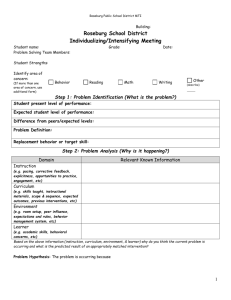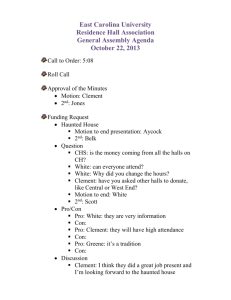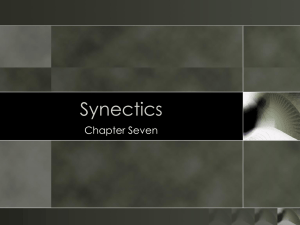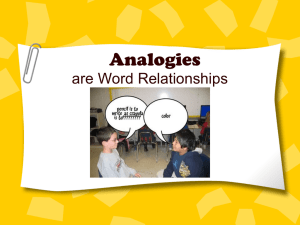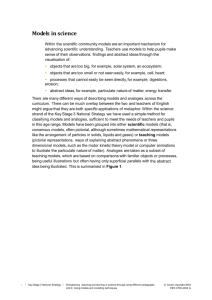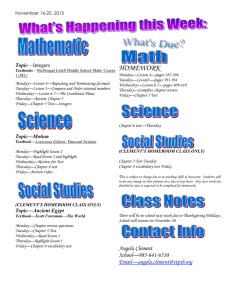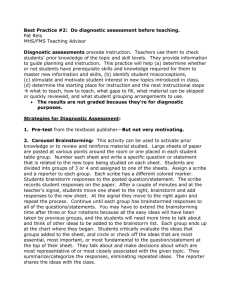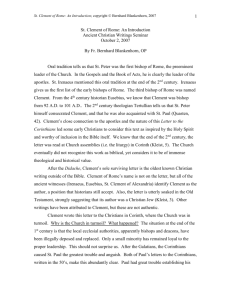Table of Contents ( 100K)
advertisement
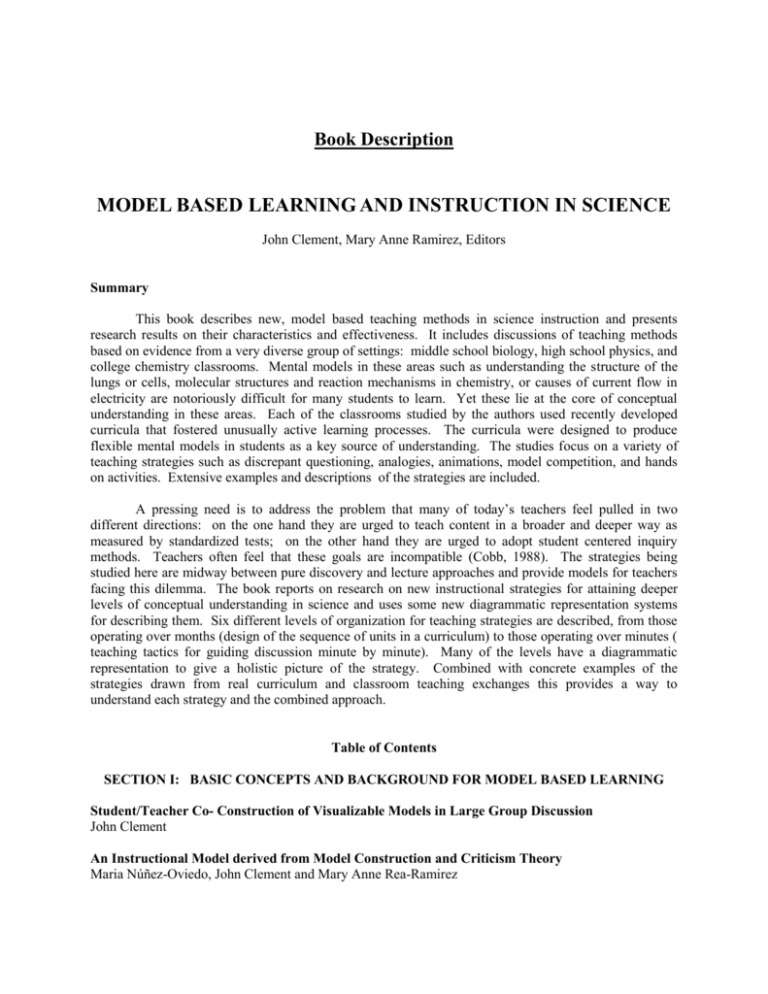
Book Description MODEL BASED LEARNING AND INSTRUCTION IN SCIENCE John Clement, Mary Anne Ramirez, Editors Summary This book describes new, model based teaching methods in science instruction and presents research results on their characteristics and effectiveness. It includes discussions of teaching methods based on evidence from a very diverse group of settings: middle school biology, high school physics, and college chemistry classrooms. Mental models in these areas such as understanding the structure of the lungs or cells, molecular structures and reaction mechanisms in chemistry, or causes of current flow in electricity are notoriously difficult for many students to learn. Yet these lie at the core of conceptual understanding in these areas. Each of the classrooms studied by the authors used recently developed curricula that fostered unusually active learning processes. The curricula were designed to produce flexible mental models in students as a key source of understanding. The studies focus on a variety of teaching strategies such as discrepant questioning, analogies, animations, model competition, and hands on activities. Extensive examples and descriptions of the strategies are included. A pressing need is to address the problem that many of today’s teachers feel pulled in two different directions: on the one hand they are urged to teach content in a broader and deeper way as measured by standardized tests; on the other hand they are urged to adopt student centered inquiry methods. Teachers often feel that these goals are incompatible (Cobb, 1988). The strategies being studied here are midway between pure discovery and lecture approaches and provide models for teachers facing this dilemma. The book reports on research on new instructional strategies for attaining deeper levels of conceptual understanding in science and uses some new diagrammatic representation systems for describing them. Six different levels of organization for teaching strategies are described, from those operating over months (design of the sequence of units in a curriculum) to those operating over minutes ( teaching tactics for guiding discussion minute by minute). Many of the levels have a diagrammatic representation to give a holistic picture of the strategy. Combined with concrete examples of the strategies drawn from real curriculum and classroom teaching exchanges this provides a way to understand each strategy and the combined approach. Table of Contents SECTION I: BASIC CONCEPTS AND BACKGROUND FOR MODEL BASED LEARNING Student/Teacher Co- Construction of Visualizable Models in Large Group Discussion John Clement An Instructional Model derived from Model Construction and Criticism Theory Maria Núñez-Oviedo, John Clement and Mary Anne Rea-Ramirez SECTION II: INTRODUCTION TO MODEL BASED TEACHING STRATEGIES Determining Target Models and Effective Learning Pathways for Developing Understanding of Biological Topics Mary Anne Rea-Ramirez Co-construction And Model Evolution In Chemistry S. Khan Target Model Sequence and Critical Learning Pathway for an Electricity Curriculum Based on Model Evolution: Applying Modeling Theory to Curriculum Design Principles Melvin Steinberg Case Study of Model Evolution in Electricity: Learning from Both Observations and Analogies John Clement and Melvin Steinberg SECTION III: QUALITATIVE RESEARCH ON SPECIFIC STRATEGIES A Competition Strategy and other Discussion Modes for Developing Mental Models in Large Group Discussion Maria Núñez-Oviedo and John Clement “What If” Scenarios For Testing Student Models In Chemistry S. Khan Applying Modeling Theory to Curriculum Development: From Electric Circuits to Electromagnetic Fields Melvin Steinberg Developing Complex Mental Models in Biology Through Model Evolution Maria Núñez-Oviedo and Mary Anne Rea-Ramirez Role of Discrepant Questioning Leading to Model Element Modification Mary Anne Rea-Ramirez. Maria Nunez-Oviedo Using Analogies in Science Teaching and Curriculum Design: Some Guidelines Mary Jane Else, John Clement and Mary Anne Rea-Ramirez Model Based Reasoning Among Inner City Middle School Students Mary Anne Rea-Ramirez and Maria Nunez-Oviedo SECTION IV: CONCLUSION Six Levels Of Organization For Curriculum Design And Teaching John Clement Annotated Table of Contents: MODEL BASED LEARNING AND INSTRUCTION IN SCIENCE SECTION I: BACKGROUND AND HISTORY OF MODEL BASED LEARNING Student/Teacher Co- Construction of Visualizable Models in Large Group Discussion Author: Clement, J. This chapter provides an introduction to model based teaching strategies. Teachers who have content goals and open up their classroom to student contributions to model construction will inevitably end up dealing with multiple misconceptions, and a variety of positive or partially correct ideas garnered from student discussions. This chapter gives examples of how partially correct pre-conceptions can be modified and built upon, and how teachers can deal with alternative conceptions in a human respiration unit. This makes large group discussions and teacher input critical if students are being asked to reach target concepts. We term the resulting process teacher-student co-construction. It also makes agenda management during large group discussions a critical issue. An example is discussed where the teacher maintains an agenda by guiding discussions to consider and reach closure on one small issue at a time. This results in an evolutionary sequence of models and revisions. An Instructional Model derived from Model Construction and Criticism Theory Authors: Núñez-Oviedo, M.C., Clement, J., & Rea-Ramirez, M. A. This chapter provides a historical background for the development of model based learning and teaching from different developments in cognitive science, educational psychology, and history of science. It begins by presenting an introduction to basic strategies in model based teaching and learning, including discrepant events, analogies, and group discussion. A central problem is how to guide instruction while engaging the active involvement of students’ in building mental models of a phenomenon. The approach derived from the evolution of the field includes two different nested cycles of model construction processes at different time scales. SECTION II: INTRODUCTION TO MODEL BASED TEACHING STRATEGIES Determining Target Models and an Effective Learning Pathway for Developing Understanding of Biological Topics Based on Explanatory Need Author: Rea-Ramirez, M. A. This chapter describes what target models are, how they are developed, and what makes a target model both accessible and achievable for students. A target model is a student’s mental model that is the goal for an instructional unit. Students should be able to use a target model effectively to explain real life situations. A target model may be simplified version of the scientist’s model and, like all models in science, it should not be considered to be complete or unrevisable. Based on research in middle school students’ preconceptions of human biology, the chapter discusses the selection of target concepts and the construction of intermediate models by students as they move toward the target concept. They can then be further defined by taking National Standards into account although these will not always be found to lead to exactly the same goals. Using target models as the goal of instruction, students are encouraged to develop relatively complex models within their level of understanding and ability. Thus target concepts are ideally determined by research on preconceptions, analysis of expert knowledge components, learning pathways, and instructional trials. . Co-construction And Model Evolution In Chemistry Author: Khan, S. Co-construction and model evolution is described in this chapter as a process of teachers guiding students’ to enrich their original models where they have greater explanatory power and can be used to make predictions. This process occurs when teachers ask students to explain relationships that are present within a model. This chapter provides examples of how teachers can help students construct enriched models. A Target Model Sequence and Critical Learning Pathway for an Electricity Curriculum Based on Model Evolution: Applying Modeling Theory to Curriculum Design Principles Author: Melvin Steinberg This chapter discusses the design of a recently developed high school electricity curriculum called the Capacitor-Aided System for Teaching and Learning Electricity (CASTLE), which aspires to enable students to construct a sequence of increasingly complex qualitative models of electric circuits. The curriculum is driven by hands-on student experiments on bulb lighting in circuits that contain batteries and capacitors, sequenced to foster a learning pathway of model modifications that add conceptual complexity gradually with low cognitive load. The growing complexity periodically requires a revised conception of causal agency. The transition from emission by a battery to pressure in a compressible fluid as the agent of current propulsion is described here. Co-construction And Model Evolution In Electricity Author: Clement, J., Steinberg, M. Co-construction in electricity for secondary students is described as a process where both teacher and student contribute to generating and evaluating models. Basic strategies described include: Model Evolution: An Evolutionary Sequence of Models and Revisions. The change from a “remove and replace” view of the change in the model to a “transformation” view that modifies aspects of an existing intermediate model. Discrepant Events: Discrepant events constrain the construction of the new model as well as creating dissonance with the old model. This approach involves a series of discrepant events rather than relying on one discrepant event. Analogies: The approaches uses a series of analogies for adding pieces to the model over an extended period of model construction, rather than relying on one quick analogy. In this approach observations are not viewed as sufficient for producing normative conceptual change. Positive sources of knowledge in the student are also used. The process relies on using both rationalanalogical (prior knowledge) as well as empirical sources of ideas rather than relying primarily one or the other. The three levels described diagrammatically reflect the theoretical position that contributions are made both "from above" and "from below" as observations interact with prior conceptions. Thus the process fits an interactionist view of learning as empirically constrained, creative model construction rather than an empiricist view of learning as generalizing from observations. SECTION III: QUALITATIVE RESEARCH ON SPECIFIC STRATEGIES A Competition Strategy and other Discussion Modes for Developing Mental Models in Large Group Discussion Authors: Núñez-Oviedo, M.C. and Clement, J. This chapter describes a teaching strategy for guiding large group discussions called model competition. The teacher has an opportunity to promote model competition when the students contribute to a discussion with ideas that are contradictory to each other. The presence of these different kinds of ideas fosters dissatisfaction in the students’ minds that can be productive. We follow the strategies a teacher uses to support this in a case study of classroom learning in the area of respiration. The teacher played a key role during the teacher/student co-construction process by constantly diagnosing the students’ ideas and encouraging the students to disconfirm, recombine, restructure, or tune their ideas and to generate successive intermediate mental models. “What If” Scenarios for Testing Student Models in Chemistry Author: Samia Khan This chapter describes a strategy aimed to help students generate and test models. The strategy involves encouraging students to create what if scenarios. What if scenarios involve speculating on or changing one or more of the parameters associated with an original model and observing the effects of the change. In terms of model-based learning, a ‘what if’ scenario is a teaching strategy that has potential to enrich or transform students’ existing models through testing. There are a variety of methods for teachers to support what if scenarios, and this chapter offers several examples from the field of chemistry. One of these involves using digital technologies, such as microworlds or web-based java applets, to provide students with virtual “test-beds” to test their models. In this chapter, I suggest ways to foster what if scenarios using such digital technologies and suggest that guidance from the instructor is important to encourage and sustain students’ thinking. Applying Modeling Theory to Curriculum Development: From Electric Circuits to Electromagnetic Fields Author: Melvin S. Steinberg This chapter describes the CASTLE high school electricity curriculum’s effort to enable students to construct increasingly complex models of electrostatic and then electromagnetic distant action. The electrostatics sequence begins where the target model sequence ended in the earlier chapter on modeling current propulsion in circuits. It describes low-tech means for investigating phenomena that can generate imagery of “potential pressure halos” in the space around charge that act on other charge located elsewhere. (Halo diagrams are visual representations of electric potential functions, and “potential pressure” is intuitive language for “electric potential”.) Space limitation requires simply stating that positive/negative charge exists in insulators and conductors, which raises/lowers electric pressure by local and distant action. Lighting by neon bulbs identifies negative mobile charge carriers (“electrons”) which are tiny compared to atoms and are present but bound in insulator atoms. Gas discharge through air shows diverging vector electric field with magnitude = gradient of potential pressure is the local causal agent. The electromagnetics sequence then describes how coaxial coils, LEDs and AM radio provide evidence that curling electric field is radiated by accelerating charge during current turn-on and turn-off and is accompanied by curling magnetic field. This explains magnetic field production and transformer action. Developing Complex Mental Models in Biology Through Model Evolution Authors: Núñez-Oviedo, M.C And Rea-Ramirez, M. A. This chapter provides a theoretical framework for describing learning processes teaching strategies in middle school biology. This framework presents new vocabulary and conceptualizations for describing the construction of mental models in large group discussion through a mode of interaction called model evolution. The teacher has an opportunity to promote model evolution when the students contribute to a discussion with ideas that are partially compatible with the target of the lesson. The teacher supports the students in modifying or repairing the ideas by fostering small successive episodes of dissatisfaction that originate cycles of model construction and criticism. We describe this strategy in a case study of classroom learning in the area of respiration. Role of Discrepant Questioning Leading to Model Element Modification Authors: Rea-Ramirez, M.A., Nunez-Oviedo, M. C. This chapter describes in more detail the strategy called discrepant questioning. Discrepant questioning can help students see difficulties in misconceptions and construct new science ideas for deep understanding. Discrepant questioning is a technique in which teachers question students in a way that requires the student to examine their ideas or models, without giving information prematurely to the student or passing judgment on the student’s model. This strategy may also be called dissonance producing, because it prompts students to see the contradictions in their model, the ways in which it is unworkable. Evidence suggests that students in classrooms where discrepant question was a major part of the curriculum produced dynamic models of respiration, constructing complex concepts into an integrated whole. Examples of discrepant questions and student reactions will be provided from classroom transcripts. Using Analogies in Science Teaching and Curriculum Design: Some Guidelines Authors: Else, M., Clement, J. and Ramirez, M., This chapter discusses the effective use of analogies in model based learning and teaching. Although analogies can be effective in helping students to understand new concepts in science, presentation of analogies can be time-consuming, and recent research indicates that elaborative processing may be needed for deep understanding. The middle-school science curriculum described was designed to give students an integrated understanding of the processing of food energy in cellular respiration and the body systems associated with the cellular processing of energy. Analogies are one of a number of "tools" used by teachers to help students build models that are similar to scientists' conceptions. They are considered the "right tool" to help students understand elements or "pieces" of the story under certain circumstances: 1) when students can not build the piece themselves through logic or experience, 2) when the element is important or prerequisite to other parts of the story, and 3) when an effective analogy is available. Model Based Reasoning Among Inner City Middle School Students Author: Rea-Ramirez, M.A., Nunez-Oviedo, M.C This chapter describes a group of inner city students engaged in the model based human biology curriculum. While significant gains in understanding were measured, we will concentrate this discussion on answering the question, “What factors were present in the inner city setting that may have contributed to or deterred success?” We began the project with the belief that learning patterns uncovered in our earlier research outside of the inner city could be developed into an effective curriculum that met the needs of most students regardless of the setting. Issues pertaining to educating specific groups of students were not considered prior to that time outside of a desire to use a variety of educational strategies based on research and exemplary practice and inclusion of both ESL and LD students in the initial research and curriculum trials. However, in studying not only the test differences but also the process of constructing understanding with a group of primarily Hispanic inner city youth, we began to see evidence that supported our hypothesis that all students could learn from a model based curriculum approach. In addition, we have found that certain social theories about educating low income and Hispanic students provide insights into why the students were successful with the curriculum. In fact, social learning research hypothesizes certain factors and strategies considered necessary for successful learning in Hispanic students that we believe are reinforced by the model based reasoning approach used in the curriculum. SECTION IV: CONCLUSION Six Levels Of Organization For Curriculum Design And Teaching Author: Clement, J. Levels of organization for teaching strategies are described as a way of organizing the findings in the book. The levels range from those operating over months (design of units in a curriculum) to those operating over minutes ( teaching tactics for guiding discussion minute by minute). Chapter findings are placed at the different levels yielding the outline of an overall theory of instruction. The chapter concludes that instructional design must include all levels to be effective in teaching an integrated curriculum for meaningful conceptual change.
